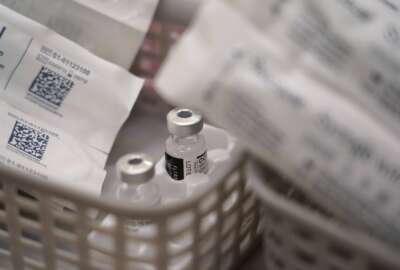

The Safer Federal Workforce task force released a new and updated FAQs to help shed some light on lingering questions about testing of unvaccinated, on-site emp...
The first update by the Safer Federal Workforce task force in more than a month is addressing the challenge of testing employees and contractors who work on-site or with the public on a regular basis for COVID-19, the types of tests that are permitted and who is responsible for paying for said tests.
The crux of the updated and new frequently ask questions is agencies have until Feb. 15 to set up a testing program “for employees who are not fully vaccinated, including due to a pending or approved request for exception or extension from the COVID-19 vaccination requirement for federal employees.”
The task force said the testing program is only for employees who work on-site or interact with the public like safety inspectors, and not for those who work remotely.
“Federal employees who are not fully vaccinated and who work on-site or interact in person with members of the public as part of their job duties on an infrequent basis should be tested at least once in the week that they are working onsite or interact in person with members of the public as part of their job duties,” the task force said. “An agency may determine that some employees who generally do not report to a worksite or interact with members of the public as part of their job duties, but may need to do so on an emergency basis (e.g., for accident investigations or disaster response) are required to undergo regular testing on a frequency determined by the agency.”
The new requirements for testing also apply to federal employees or contractors visiting other agencies.
The task force said these folks should be considered visitors and would need to show proof of a negative COVID-19 test result administered within the past three days.
Additionally, the task force instructs agencies to work with employee unions to develop specific testing plans as part of meeting collective bargaining obligations.
The number of federal employees that would require testing is relatively small. All told, some 97.2% of the workforce is at least partially vaccinated or has a medical or religious exception pending or approved, OMB said in December 2021.
The contractor mandate also is up in the air as the Supreme Court is hearing a challenge to the vaccine mandate because the Biden administration overstepped its authority to require businesses with at least 100 employees to demand vaccines or regular testing. The case before the Supreme Court isn’t specifically for contractors — just for businesses with more than 100 employees.
While the contractor mandate works through the court system, the federal employee mandate continues to evolve.
The task force also highlighted the types of tests that are permissible as part of the testing center. It said both types of viral tests, as well as commercially available tests from pharmacies or those that include a telehealth component.
“Agencies should establish a means of verifying the date and result of a test — the test should not be both self-administered and self-read by the employee unless observed by the agency or an authorized onsite or telehealth provider,” the task force said. “If the results are provided to the federal employee or contractor employee who was tested, the agency should establish a means for the federal employee or contractor employee to provide those results to the appropriate agency staff for verification that required testing has been completed and the employee has tested negative. Agencies must comply with applicable privacy safeguards and regulations when receiving test results.”
Agencies are required to pay for testing of employees, both their own and those visiting under official business. Additionally, testing is part of an employee’s normal workday, and if the test takes more time, normal overtime rules apply.
The task force also clarified what happens if an employee tests positive for COVID and how record-keeping should work, including adding the case in the OSHA Illness and Injury Log if the case is work-related and involves one or more relevant recording criteria such as medical treatment beyond first aid and days away from work.
Agencies still are deciding how quickly to bring employees back to the office. The plans that Federal News Network recently reviewed suggest some federal managers, supervisors and senior executives will return to their offices with more frequency in early January, but bargaining unit employees won’t face similar requirements until later.
Under guidance from the Biden administration, employees are supposed to get at least 30 days’ advanced notice before returning to an office or work site.
Copyright © 2024 Federal News Network. All rights reserved. This website is not intended for users located within the European Economic Area.
Jason Miller is executive editor of Federal News Network and directs news coverage on the people, policy and programs of the federal government.
Follow @jmillerWFED

